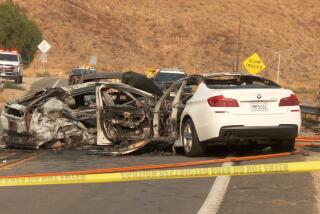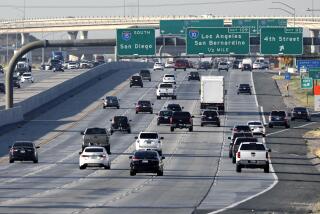Driver Reaction Led to Pileups, NTSB Says
- Share via
WASHINGTON — The National Transportation Safety Board found Monday that a phenomenon it calls “non-uniform driver response” was to blame for six multi-vehicle highway pileups in fog and dust--three of them in California last year.
The bureaucratic language, said NTSB Chairman Carl W. Vogt, means that drivers slowed down at different rates of speed, if at all, when they could no longer see. The tangled crashes that resulted reminded witnesses of wartime strafing raids.
“I’ve run into fog traveling down the San Joaquin Valley,” said NTSB member John K. Lauber at a public hearing on the board’s study, “and you want to slow down to keep better control. But if you do, some kook is going to run up your rear end.”
The two fog-related California accidents studied by the board included an 18-vehicle crash on Interstate 5 near Buttonwillow on Jan. 9, 1991, causing two deaths and 10 injuries, and a 75-vehicle chain-reaction on California 99 near Fresno on Feb. 7, 1991, causing four deaths and 31 injuries.
The largest accident studied occurred in a dust storm and involved 164 vehicles near Coalinga on Interstate 5 on Nov. 29, 1991. Seventeen people died and 151 were injured.
Collisions in limited visibility conditions have killed 6,804 people in 10 years on U.S. highways--an average of 680 per year, the board reported.
Ron Weber, an NTSB highway engineer, told the board hearing that Caltrans has explored several ways to educate and warn drivers about limited visibility hazards since the accidents last year.
Among these are pamphlets for drivers describing the best ways to handle fog and dust visibility problems, portable message signs along highways and portable advisory radio stations. Weber called the results promising.
Caltrans also has experimented with halting huge trucks at rest stops and “metering” them back into the highway traffic flow at regular intervals, Weber said. But this approach has not worked well because of the large volume of trucks on California highways.
The board acknowledged that its general conclusion about the accidents--that varying speed was to blame--is “not satisfying,” as Lauber put it, particularly because it is unable to offer any single or simple way to reduce the danger.
“We have to consider it (the occurrence of multi-vehicle crashes) a failure of the system,” said Lauder, “of training, education, behavior, enforcement, engineering.”
“The fundamental problem is how to influence driver behavior,” Vogt said.
The board found that driver education manuals do not adequately cover the issue of how to behave when visibility abruptly drops to near zero and it appeared unconvinced that motorists who attend superior driver education courses are better prepared than those who attend lower-rated courses.
Technology should help if it can be made cost-effective, Vogt said. In Holland, devices embedded in roadways sense traffic slowdowns and send signals to warning signs that within 12 seconds can advise motorists to slow down. But the board is not ready to recommend comparable systems in this country, he said.
Chief among the fog-related accidents studied by the board was a 99-vehicle collision near Calhoun, Tenn., on Dec. 11, 1990, in which 12 people died and 42 were injured.
It concluded that routine patrols by state police in Tennessee, and elsewhere, are not able to give motorists timely warnings of fog, in part because the fog occurs and dissipates too rapidly.
More to Read
Sign up for Essential California
The most important California stories and recommendations in your inbox every morning.
You may occasionally receive promotional content from the Los Angeles Times.










